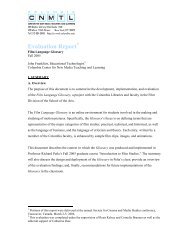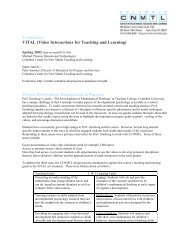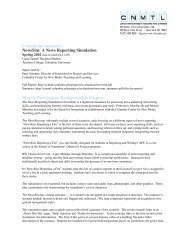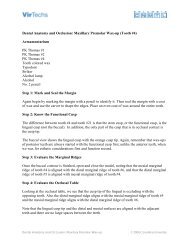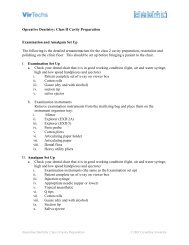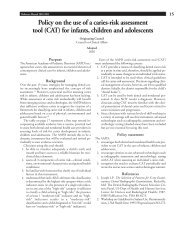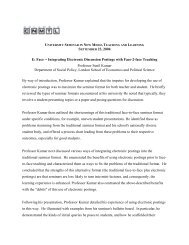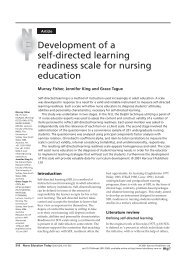Film Language Glossary Evaluation Summary - Columbia Center for ...
Film Language Glossary Evaluation Summary - Columbia Center for ...
Film Language Glossary Evaluation Summary - Columbia Center for ...
You also want an ePaper? Increase the reach of your titles
YUMPU automatically turns print PDFs into web optimized ePapers that Google loves.
<strong>Evaluation</strong> <strong>Summary</strong><br />
<strong>Film</strong> <strong>Language</strong> <strong>Glossary</strong><br />
Fall 2005<br />
John Frankfurt, Educational Technologist<br />
<strong>Columbia</strong> <strong>Center</strong> <strong>for</strong> New Media Teaching and Learning<br />
Full report: http://ccnmtl.columbia.edu/projects/evaluations/filmglossary.pdf<br />
Overview<br />
The purpose of this document is to summarize the development, implementation, and evaluation<br />
of the <strong>Film</strong> <strong>Language</strong> <strong>Glossary</strong>, a project with the <strong>Columbia</strong> Libraries and faculty in the <strong>Film</strong><br />
Division of the School of the Arts.<br />
The <strong>Film</strong> <strong>Language</strong> <strong>Glossary</strong> is an online environment <strong>for</strong> students involved in the making and<br />
studying of motion pictures. Specifically, the <strong>Glossary</strong>’s focus is on defining terms that are<br />
representative of the major categories of film studies: practical, technical, and historical, as well<br />
as the language of business, and the language of criticism and theory. Each entry, written by a<br />
member of the <strong>Columbia</strong> faculty, is enhanced by sample film clips, images, and animations.<br />
This document describes the context in which the <strong>Glossary</strong> was produced and implemented in<br />
Professor Richard Peña’s Fall 2005 graduate course “Introduction to <strong>Film</strong> Studies.” The summary<br />
will also discuss the design and deployment of the <strong>Glossary</strong> in Peña’s class; provide an overview<br />
of the evaluation findings; and, finally, recommendations <strong>for</strong> future implementations of the<br />
<strong>Glossary</strong> in the classroom.<br />
SUMMARY OF FINDINGS<br />
Overall, the design and deployment of the <strong>Glossary</strong> supported the curricular objectives of Richard<br />
Peña’s “Introduction to <strong>Film</strong> Studies.” With the site integrated into the course objectives, students<br />
connected the <strong>Glossary</strong> with course content taught by Peña and made use of the various resources<br />
on the site <strong>for</strong> class discussions, screenings, readings, and course papers. Cross-referencing terms
improved students’ abilities to rein<strong>for</strong>ce and recognize the various connections that exist among<br />
the film terms covered by Peña. In addition, video clips that include faculty commentary and<br />
graphic annotations further supported the students' understanding of a term and how it applies<br />
across various films. The <strong>Glossary</strong> should continue to be offered and developed as a pedagogical<br />
tool in Peña’s introductory class.<br />
It is difficult to determine whether the implementation of the <strong>Glossary</strong> in classes other than<br />
Peña’s helped achieve the pedagogical goals of these courses. Data is mixed as far as which site<br />
elements were helpful and which were not in classes other than Peña’s as these courses tended to<br />
use the <strong>Glossary</strong> only as a general resource and did not to recognize any intellectual architecture<br />
of the site. The architecture of the <strong>Glossary</strong> was based on Peña's methodology of teaching film<br />
vocabulary, but not in a manner that would <strong>for</strong>ce a user to go through the site exactly as it is<br />
taught in Peña’s introductory class. By implementing the <strong>Film</strong> <strong>Language</strong> <strong>Glossary</strong> as an active<br />
classroom tool, as opposed to a general resource, we begin to indicate how we might redefine our<br />
understanding of digital glossaries in education. In order to meet the long-term goal of making the<br />
<strong>Film</strong> <strong>Language</strong> <strong>Glossary</strong> an extensive learning tool that can be repurposed <strong>for</strong> many courses, in<br />
the <strong>Film</strong> Division and beyond, continued strategies <strong>for</strong> rein<strong>for</strong>cing class expectations and<br />
supporting student interaction are recommended <strong>for</strong> the direct integration and subsequent<br />
evaluation of the <strong>Glossary</strong>.<br />
2





